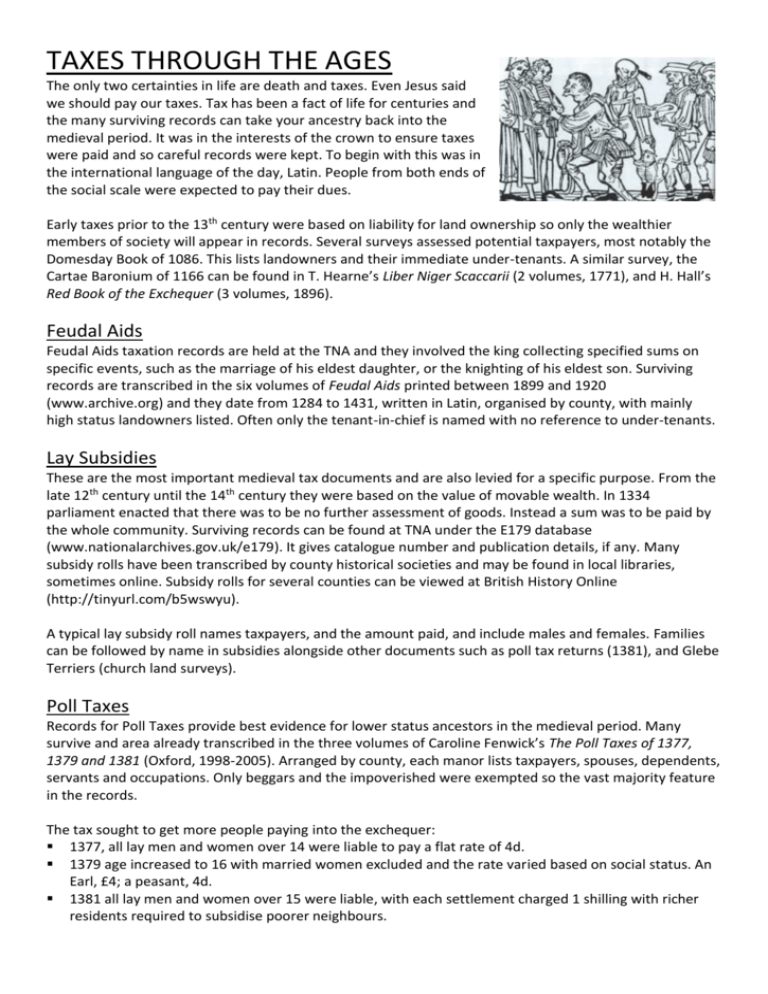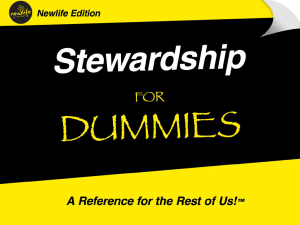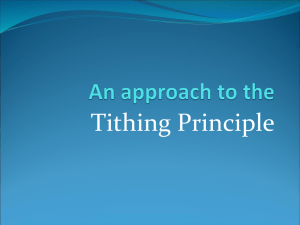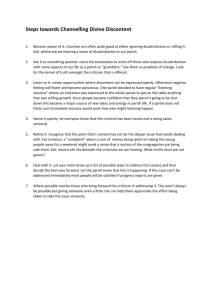Tax & Tithe handout
advertisement

TAXES THROUGH THE AGES The only two certainties in life are death and taxes. Even Jesus said we should pay our taxes. Tax has been a fact of life for centuries and the many surviving records can take your ancestry back into the medieval period. It was in the interests of the crown to ensure taxes were paid and so careful records were kept. To begin with this was in the international language of the day, Latin. People from both ends of the social scale were expected to pay their dues. Early taxes prior to the 13th century were based on liability for land ownership so only the wealthier members of society will appear in records. Several surveys assessed potential taxpayers, most notably the Domesday Book of 1086. This lists landowners and their immediate under-tenants. A similar survey, the Cartae Baronium of 1166 can be found in T. Hearne’s Liber Niger Scaccarii (2 volumes, 1771), and H. Hall’s Red Book of the Exchequer (3 volumes, 1896). Feudal Aids Feudal Aids taxation records are held at the TNA and they involved the king collecting specified sums on specific events, such as the marriage of his eldest daughter, or the knighting of his eldest son. Surviving records are transcribed in the six volumes of Feudal Aids printed between 1899 and 1920 (www.archive.org) and they date from 1284 to 1431, written in Latin, organised by county, with mainly high status landowners listed. Often only the tenant-in-chief is named with no reference to under-tenants. Lay Subsidies These are the most important medieval tax documents and are also levied for a specific purpose. From the late 12th century until the 14th century they were based on the value of movable wealth. In 1334 parliament enacted that there was to be no further assessment of goods. Instead a sum was to be paid by the whole community. Surviving records can be found at TNA under the E179 database (www.nationalarchives.gov.uk/e179). It gives catalogue number and publication details, if any. Many subsidy rolls have been transcribed by county historical societies and may be found in local libraries, sometimes online. Subsidy rolls for several counties can be viewed at British History Online (http://tinyurl.com/b5wswyu). A typical lay subsidy roll names taxpayers, and the amount paid, and include males and females. Families can be followed by name in subsidies alongside other documents such as poll tax returns (1381), and Glebe Terriers (church land surveys). Poll Taxes Records for Poll Taxes provide best evidence for lower status ancestors in the medieval period. Many survive and area already transcribed in the three volumes of Caroline Fenwick’s The Poll Taxes of 1377, 1379 and 1381 (Oxford, 1998-2005). Arranged by county, each manor lists taxpayers, spouses, dependents, servants and occupations. Only beggars and the impoverished were exempted so the vast majority feature in the records. The tax sought to get more people paying into the exchequer: 1377, all lay men and women over 14 were liable to pay a flat rate of 4d. 1379 age increased to 16 with married women excluded and the rate varied based on social status. An Earl, £4; a peasant, 4d. 1381 all lay men and women over 15 were liable, with each settlement charged 1 shilling with richer residents required to subsidise poorer neighbours. These returns provide considerable information and are easily cross-referenced with other medieval sources including manorial accounts, and manorial court rolls. Hearth Tax Extremely unpopular, complicated and inefficient Hearth Tax records were country-wide listings of householders from the 1600s. Following the restoration of the monarchy in 1660, parliament calculated that the Royal Household of Charles II needed an annual income of £1.2 million. There was a shortfall of £300,000 so the Hearth Tax was introduced, which had already been tried in other parts of Europe. Also known as ‘hearth money’, chimney tax’ or ‘chimney money’ it was believed easier to impose than a tax on people, who tended to move about! It received Royal Assent on 19 May 1662 with the first payment due on Michaelmas Day on the 29 September. It was eventually repealed in England and Wales in 1689 as at attempt to gain popularity by William and Mary. It was not abolished in Ireland until 1795. In Scotland it was only levied between 1691 and 1695. Hearth Tax was payable at Michaelmas and Lady Day (25 March) at a rate of one shilling “for every firehearth and stove” in “every dwelling and other house and edifice”. In other words, two shillings per hearth or stove per year. Initially this was paid by the occupiers, or by the owners if the property was empty, with no exceptions. Later exemptions meant only the occupier had to pay. Further exemptions included: those paying poor or church rates; those inhabiting a house, tenement or land worth less than 20 shillings rent per annum; those with assets worth under £10; private ovens, furnaces, kilns and blowing houses; hospitals and almshouses with revenues under £100 per year. Exemptions did not cover forges, locksmiths or bakers’ ovens. From 1664 everyone with more than two hearths was liable, even if they were otherwise exempt. Following a revising act in 1663 names of householders and numbers of hearths had to be recorded even if exempt. What began as a simple and equitable tax soon became over-complicated. It was administered by receivers, known as ‘chimney men’ who were helped by sub-collectors and petty constables. They had the right to enter any property and inspect the number of hearths. This caused wide resentment as a gross invasion of privacy. Those avoiding payment by blocking up chimneys had to pay double. There are a variety of surviving records including Assessments and returns, exemption certificates and schedules of payment. They contain names, and assessments give names of individual householders with status and title sometimes, and the number of chargeable hearths, with occasionally the amount payable. Exemption certificates had to be signed by a minister, a churchwarden or overseer of the poor and two JPs. From 1670 printed exemption forms were used. It is important to note that each hearth tax list is a combination of several people’s work, so the details are not consistent. Being copies of original working lists they are subject to inaccuracy. Also many records have been damaged during moves and due to damp. www.progenealogists.com/greatbritain/hearthtax.htm offers detailed information, resources and links to locate transcribed records in the UK and Ireland. At the TNA the records appear in E179 and a database has been produced listing the places covered at www.nationalarchives.gov.uk/e179. See also www.britishhistory.ac.uk has records for London (1662), Westminister (1664) and City of London and Middlesex (1666). There were variations in the ways the tax was administered and collected. 1662-1666, and 1669-1674 was controlled by the Exchequer, when one copy was returned to the Exchequer (now at TNA) with another held by the Clerk of the Peace. Outside of these periods collection was privatised, ‘farmed out’, and returns not required by the Exchequer. Records can be found at local record offices, usually with Quarter Sessions records and at the British Library. Although the poor were often never listed elsewhere these records hold nearly every householder at least once. This is the nearest we have to a census of mid 17th century Britain. Window Tax This was a property tax of the number of windows in a house. To avoid the tax some bricked-up window-spaces (ready to be glazed or reglazed at a later date). In England and Wales it was introduced in 1696, repealed in 1851. The tax was introduced in England and Wales under An Act for granting to His Majesty severall Rates or Duties upon Houses for making good the Deficiency of the clipped Money [Chapter XVIII. Rot. Parl. 7&8 Guil. III. p. 5. n. 4] in 1696 under King William III and was designed to impose tax relative to the prosperity of the taxpayer. Many people in Britain opposed income tax because they believed the disclosure of personal income was an unacceptable governmental intrusion into private matters, and a potential threat to personal liberty. In fact the first permanent British income tax was not introduced until 1842, and the issue remained intensely controversial well into the 20th century. Window tax consisted of two parts: a flat-rate house tax of 2 shillings per house and a variable tax for the number of windows above ten in the house. Properties with between ten and twenty windows paid a total of four shillings and those above twenty windows paid eight shillings. The number of windows that incurred tax was changed to seven in 1766 and eight in 1825. The flat-rate tax was changed to a variable rate, dependent on the property value, in 1778. People who were exempt from paying church or poor rates, for reasons of poverty, were exempt from the window tax. Window tax was relatively unintrusive and easy to assess. Certain rooms, particularly dairies, cheese-rooms and milk-houses were exempt providing they were clearly labeled, and it is not uncommon to find the name of such rooms carved on the lintel. The bigger the house, the more windows it was likely to have and the more tax the occupants would pay. Nevertheless, the tax was unpopular, because it was seen by some as a tax on "light and air". The few which do survive may be found at county record offices. Land Tax Introduced in England and Wales in 1693 to replace the Hearth Tax, Land Tax was relatively straightforward and effective. It began by a simple sum per pound of property value, but after 5 years was replaced by a quota system, with each county expected to pay a specified sum each year. This was divided into parishes proportionate in size and wealth. Each parish or township then claimed a share from each landowner, based upon the value of his or her property. Throughout the 18th century the tax was an annual levy and there was never a reassessment of value so it became more controversial as years passed by and property values changed. It continued until 1832 but in 1798 a desperate need for money to fight the French led the government to allow landowners to redeem the tax by paying a sizeable one-off lump sum covering several years of tax on their property. Few land tax records survive prior to 1780 but in that year the rules changed and a duplicate copy of each parish or township land tax return was sent to the clerk of the peace, the chief administrative officer for the county. Thus, voter’s lists were then compiled for parliamentary elections from these property records based upon values. After 1832 these were no longer needed because of the electoral changes enacted by the Great Reform Acts. These duplicate returns were deposited among Quarter Sessions records and can be found at county record offices. They are standardised and list names and amounts paid with very rare details of properties. TNA has records under 1R 22, arranged geographically and not indexed by person. IR 23 is the entire 1798 Land Tax returns for England and Wales, copied into 121 volumes and annotated to show redemption and certification. IR 24 is a set of volumes issued on redemption which record brief property details and its location. The certificates are not filed numerically or arranged geographically or by names. The lists in IR 22 and returns in IR 23 act as the indexes. Valuation and Field Books In 1909 the Liberal administration revived the land taxation because the many very rich were paying proportionately little tax because their wealth was largely tied to land and property. District Valuation Offices of the Inland Revenue recorded in great detail ownership, description and valuation of almost every property in the country. This continued until the 1920s though disrupted by WW1, but the tax was never levied because it was politically very contentious and because it required frequent and prohibitively expensive revaluations. The Finance Act 1910 (Lloyd George’s “Domesday”) records are split. Local archives usually hold two sets of documents including valuation books arranged by parish or township that give a property reference number which cross-references maps at a scale of 25 inches to a mile and showing property boundaries. They usually include occupier names, owner, and a basic description of the property. TNA has another set of records including the field books containing very detailed descriptions of individual properties packed with facts and comment. Arranged by parish they use the same reference numbers as the maps and parish books. So for 1780 to 1832 there are excellent records but before and after, little survives. Estate and Death Duties The Inland Revenue Registers of Death duty, 1796-1903 contain unique information relating to both the deceased and the beneficiaries. The absence of a comprehensive name index is why they have been rarely used by family historians. These records show the levy of three taxes: o Legacy duty (see below) o Succession duty, introduced in 1853. Property did not need to be willed but might descend due to Inheritance laws or a deed. These are found at TNA IR 26/4868-6282. o Estate duty Under the Legacy Duty Act of 1796, duty was paid on legacies and residues of personal estate of £20 or more bequeathed by will or left by intestates and not on leases, freeholds and real estate; inheritance by near relatives (children, spouses, parents, grandparents) was exempt. Amounts payable depended upon estate value and the relationship of the beneficiary to the deceased, which itself changed over the years with increasingly more estates becoming liable. In 1805 a further Legacy Duty Act was extended to cover everyone, except the spouse and parents of the deceased. In 1975 all these duties were replaced by Capital Transfer Tax. The gradual extension of such taxes from 1796 results in the registers containing references to a variety of wills and administrations. Before 1805, registers contain entries for very few estates (c25%) particularly where it passed to a next-ofkin who was exempt. 1805-1815, c75% are covered by registers, and by 1857 all estates should be covered except those under the threshold. The Board of Stamps (Stamp Duty!), which administered the tax may not have pursued collection if the assets were valued at under £1,500 and the registers are unlikely to reveal much detail. Registers are found in several series each indexed separately: PCC wills 1796-1811 PCC administrations 1796-1857 Country Court wills and administrations 1796-1811 Country Court administrations 1812-1857 All wills 1812-1881 All administrations 1858-1881 All wills and administrations 1882-1903 Many registers for 1894-1899 were badly destroyed or damaged by fire. Registers ended in 1903 and were replaced by individual personal files which were sadly systematically destroyed after 30 years. Registers are on large printed pages divided into columns where the details were written spreading across two adjacent pages. Information includes: Name of deceased Date of will Amount it contained Court and date of probate Name and address of executors Details of estate Amount of duty paid Registers are never closed and annotations can be made years after the original entry. There is a complex list of abbreviations used and a key to these can be accessed at TNA research guide, ‘Death duties 17961903’: further research (www.nationalarchives.gov.uk/records/research-guides/death-duty-records-1796to-1903.htm). Indexes to the registers is found at TNA on microfilm at IR 27/1-605, arranged by year (no indexes for intestates for 1864-81), then by name of the deceased in an alphabetical index. These can be browsed at www.findmypast.co.uk. The registers themselves are found on microfilm at TNA IR 26/1-4855; 6283-8743 until 1857. From 18581903 you need to consult the original registers, not microfilm. Microfilm records are often difficult to read due to the use of coloured ink or pencil. Some early registers have now been digitised and can be found at http://discovery.nationalarchives.gov.uk. Digital images can be purchased for £3.36 or free in person at TNA. Typical death duty transcriptions for various years which illustrate information for each year can be found at www.gomezsmart.myzen.co.uk/wills/ddw1812.htm. Estate Duty indexes can be accessed on microfilm up to 1903 at county record offices and libraries under the title of the National Calendar of Wills and Administrations recently made available on www.ancestry.co.uk. All wills from 11 January 1858 are held by the Court of Probate (Principal Probate Registry), known as the Index of Grants, and produced each year from 1858. They can be searched at the Probate Registry Search Room in Holborn, London where copies of wills can be ordered. You can check if indexes to registers are available locally at www.genuki.org.uk/big/eng/Probate.html. There is a large collection of wills images at www.thegenealogist.co.uk. Other help might be found at www.ancestor-search.info/NAT-Probate.htm. Where wills have been disputed there may be help found at the British Origins Inheritance Disputes Index (www.origins.net). Rates Some say that local government finance is the most boring subject in the world, but it offers a wealth of records for the family historian. Key among them is the Rate Book, which records payment of rates a tax on property applicable to both business and domestic properties. These are used by house historians to trace when residences were built or changed and who lived in them. Rate books will tell us how much our ancestors’ homes were worth. If several volumes are consulted they can reveal when a family moved to a parish or when the property was changed, or changed hands. You may discover what the property was used for; who owned it and it will be a useful alternative to street directories and censuses. It may help to trace down someone you cannot find in either although it only names the ratepayer, not members of the family. As the very poorest were exempt they are not always included, but the collectors might note them as ‘poor’ or ‘pauper’. The original purpose of rates was to raise money for the churches, but by the Reformation of Henry VIII they were beginning to be used for other matters non-ecclesiastical. In 1530 Rates were used for bridge repairs followed by rates to repair gaols. Rates are simple in theory at least: A house rated at £20 per year (as estimated income from renting for 12 months). Each house in a parish was assessed in this way as were commercial premises. Rates were levied at a specific number of pence or shillings in the pound. For example: a house of rateable value £20 subject to a seven pence levy means the rate was 11s 8d. In the 18th and early 19th centuries determining the precise level of taxation at the beginning of the year was virtually impossible, particularly in semi-rural parishes where a sudden flood might overwhelm a parish’s reserves. Rates were therefore levied as they were required. Collecting was also difficult as householders either couldn’t pay or they objected to the valuation. Appeals were heard by a local JP. The poor rate was the most important as it paid for the Poor Law, maintaining workhouses and providing pensions to elderly and infirm. This is part of the reason that workhouses were so dreadful as ratepayers refused to pay higher costs. Other things that may be covered are sewers, levied by commissioners of sewers, highways and sometimes church rates for the upkeep of the local parish church – much to the disgust of any nonconformists but that was abolished in 1868. In 1925 all types of rates were merged into one general rate until replaced by the council tax during the 1990s. In most places rates were collected by the constable of the parish until professional police forces came into being in the mid-1800s. These were replaced by part-time rate collectors who recorded payments and arrears in rate books that were then checked by the parish authorities. You may occasionally discover copies of receipts given for payment. The earliest rate books survive from the 1500s but most begin in 1744 when the right to inspect rate books was introduced. There may be gaps where books have been lost or where only select volumes were retained. Few survive up to the 1960s but those that do can be found in record offices and local studies sections of libraries, arranged by town or parish, then by district, or township or ward. Most books are for only the poor rate but others may survive too. The earliest were written into account books belonging to overseers and churchwardens. These usually list householder’s name, amount payable. Where notebooks exist they were completed by the parish constable as he called house to house. Later printed books were used by rate collectors but what was recorded varies by parish. They usually contain houses listed street by street, the value, householder’s name, and amount assessed, and the owner’s name may be included too. Generally rate books are arranged by street not by ratepayer’s name so you will need to know addresses before your search starts. This may be further complicated by the route taken by the collector. Other Taxes over time Largely levied on the wealthy they include some strange taxes: Hair Powder Tax – found in Quarter session records at local record offices. Examples can be found at www.treelines.co.uk/OPC/opcintro.html. 1549 Poll tax on sheep – Examples found in www.nationalarchives.gov.uk/e179. Carriages tax 1747-1782 Silver plate tax 1756-1777 Game animals and birds 1784-1807 Horses used for transport 1784-1874 Female servants 1785-1792 Coats of Arms 1793-1882 Empty houses 1851-1924 Male servants 1777-1852 RESOURCES TNA podcast about Land Taxes – www.nationalarchives.gov.uk/podcasts/land-tax.htm Scottish valuation rolls – www.scotlandspeople.gov.uk/content/help/index.aspx?r=554&2080. www.theglasgowstory.com/valintro.php. Irish Griffiths Valuation records – www.askaboutireland.ie/griffith-valuation/index.xml Land Tax Redemption material from TNA – http://search.ancestry.co.uk/search/db.aspx?dbid=2319 Online searching for Hearth Taxes – www.hearthtax.org.uk Michael Turner and Dennis Mills, Land and Property: the English Land Tax, 1692-1832, (Alan Sutton, 1986). Jeremy Gibson, Mervyn Medlycott and Dennis Mills, Land and Window Tax Assessments, (FFHS, 1998). Jeremy Gibson, The Hearth Tax, other later Stuart Tax Lists and the Association Oath Rolls, (FFHS, 1996, 2nd Ed). T. Hearne, Liber Niger Scaccarii (2 volumes, 1771), and H. Hall’s Red Book of the Exchequer (3 vols, 1896). Caroline Fenwick, The Poll Taxes of 1377, 1379 and 1381 (Oxford, 1998-2005). W.E. Tate, The Parish Chest, (Phillimore, 1983). Anthony Adolph, Tracing Your Home’s History, (Collins, 2006). Nick Barratt, Guide to Your Ancestors’ Lives, (Pen & Sword, 2010). W. R. Ward, The Administration of the Window and Assessed Taxes, 1696-1798, English Historical Review, vol. 68 (1952), pp. 522-542. INCOME TAX Income tax was first implemented in the UK by William Pitt the Younger in 1798 to pay for weapons and equipment for the Napoleonic Wars. Pitt's new graduated (progressive) income tax began at a levy of 2d in the pound on incomes over £60 and increased up to a maximum of 2 shillings (10%) on incomes of over £200. Pitt hoped that the new income tax would raise £10 million, but actual receipts for 1799 totaled just over £6 million. Pitt's income tax was was abolished by Henry Addington in 1802 during the Peace of Amiens. It was reintroduced by Addington in 1803 when hostilities recommenced, but abolished in 1816, one year after the Battle of Waterloo. Addington's Act for a ‘contribution of the profits arising from property, professions, trades and offices’ (the words ‘income tax’ were deliberately avoided) introduced two significant changes: 1. It allowed taxation at the source; for instance, the Bank of England would deduct an amount, to be paid as tax, from interest paid to gilt holders. 2. It introduced schedules: Schedule A (tax on income from UK land) Schedule B (tax on commercial occupation of land) Schedule C (tax on income from public securities) Schedule D (tax on trading income, income from professions and vocations, interest, overseas income and casual income) Schedule E (tax on employment income) Income not falling within those schedules was not taxed. (Later a sixth Schedule, Schedule F (tax on UK dividend income) was added.) Although the maximum tax rate under Addington's Act was 5%, the other changes resulted in a 50% increase in revenue as it doubled the number of persons liable to pay and expanded the scope. Pitt in opposition had argued against Addington's innovations: he adopted them largely unchanged, however, when he returned to office in 1805. The one major change he made was to raise the maximum rate back to the 10%, the rate in his original bill, in 1806. Income tax changed little for the duration of the Napoleonic Wars, despite changes in government. Nicholas Vansittart was Chancellor in 1815, at the time of the Battle of Waterloo. He was inclined to maintain the income tax, but public sentiment was heavily against it, and predictably, the opposition championed its abolition. It was thus repealed in 1816 ‘with a thundering peal of applause’. In fact, the tax was so unpopular that Parliament ordered the destruction of all documents connected with it. This was more show than substance, as the King's Remembrancer had made duplicates and retained them. The general election of 1841 was won by the Conservatives with Sir Robert Peel as Prime Minister. Although he had opposed the unpopular income tax during the campaign, an empty Exchequer and a growing deficit gave rise to the surprise return of the tax in his 1842 Budget. Peel sought only to tax those with incomes above £150, and he reduced customs duties on 750 articles out of a total number taxed of 1,200. The less wealthy benefited, and trade revived as a consequence. Peel's income tax was imposed for three years, with the possibility of a two-year extension. A funding crisis in the railways and increasing national expenditure ensured that it was maintained. For Peel, the debate was academic. In 1846 he repealed the Corn Laws which supported farmers by inflating the price of corn when cheaper imports were available - and lost the support of much of his party. The Whigs resumed power the same year to be joined by some notable 'Peelites'. Disraeli opposed Peel's repeal of the Corn Laws which had inflated the price of imported grain to support home farmers. Formerly a Conservative, Gladstone supported the repeal of the Corn Laws and moved to the opposition (Whigs, and from 1868 Liberals). Disraeli and Gladstone agreed about little, although both promised to repeal income tax at the 1874 General Election. Disraeli won - the tax stayed (and probably would have done under Gladstone too). Gladstone spoke for nearly five hours introducing his 1853 Budget. He outlined plans for phasing out income tax over seven years (which the Crimean War was to upset), of extending the tax to Ireland, and introduced tax deductions for expenses 'wholly, exclusively and necessarily' incurred in the performance of an office - including keeping and maintaining a horse for work purposes. The 1853 Budget speech included a review of the history of the tax and its place in society, it is regarded as one of the most memorable ever made. With the Whigs defeated in 1858, Disraeli returned as Chancellor and in his Budget speech described income tax as 'unjust, unequal and inquisitorial' and 'to continue for a limited time on the distinct understanding that it should ultimately be repealed'. But the Conservatives return to power was shortlived. From 1859 to 1866, the Whigs were back with Viscount Palmerston as Prime Minister and Gladstone as Chancellor. Gladstone had set 1860 as the year for the repeal of income tax, and his Budget that year was eagerly awaited. Ill health caused it to be delayed and for his speech to be shortened to four hours. But he had to tell the House that he had no choice but to renew the tax. The hard fact was that it raised £10 million a year and Government expenditure had increased by £14 million since 1853 to £70 million (these figures should be multiplied by 50 for a modern equivalent). Gladstone was still determined that income tax should be ended. When a Select Committee was set up against his wishes to consider reforms which might preserve it, he packed the committee with supporters to ensure that no improvements could be made. In 1866, the Whigs' modest attempts at Parliamentary reform failed to win support in Parliament and the Conservatives returned to power, although with no overall majority. Disraeli succeeded where Gladstone had failed, seeing the Reform Bill of 1867 become law. This gave the vote to all householders and to those paying more than £10 in rent in towns - and so enfranchising many of the working class for the first time. Similar provisions for those living in the country came with Gladstone in 1884. While Disraeli had gambled that an increased electorate would ensure a Conservative majority, and in 1868 he was Prime Minister, the election of that year saw the Liberals - as the Whigs had become victorious under Gladstone. Income tax was maintained throughout his first Government, and there were some significant changes made including the right to appeal to the High Court if a taxpayer or the Inland Revenue thought the decision of the appeal Commissioners was wrong in law. But there was still a determination to end it. The Times, in its 1874 election coverage, said 'It is now evident that whoever is Chancellor when the Budget is produced, the income tax will be abolished'. Disraeli won the election, Northcote was his Chancellor and the tax remained. At the time it was contributing about £6 million of the Government's £77 million revenue, while Customs and Excise contributed £47 million. It could have been ended, but at the rate at which it was applied (less than 1%) and with most of the population exempt, it was not a priority. With worsening trade conditions, including the decline of agriculture as a result of poor harvests and North American imports, the opportunity never arose again. UK income tax has changed over the years. Originally it taxed a person's income regardless of who was beneficially entitled to that income, but now a person owes tax only on income to which he or she is beneficially entitled. Most companies were taken out of the income tax net in 1965 when corporation tax was introduced. These changes were consolidated by the Income and Corporation Taxes Act 1970. Also the schedules under which tax is levied have changed. Schedule B was abolished in 1988, Schedule C in 1996 and Schedule E in 2003. For income tax purposes, the remaining schedules were superseded by the Income Tax (Trading and Other Income) Act 2005, which also repealed Schedule F completely. The Schedular system and Schedules A and D still remain in force for corporation tax. The highest rate of income tax peaked in the Second World War at 99.25%. It was then slightly reduced and was around 90% through the 1950s and 60s. In 1971 the top rate of income tax on earned income was cut to 75%. A surcharge of 15% kept the top rate on investment income at 90%.In 1974 the cut was partly reversed and the top rate on earned income was raised to 83%. With the investment income surcharge this raised the top rate on investment income to 98%, the highest permanent rate since the war. This applied to incomes over £20,000. In 1974 750,000 people were liable to pay the top-rate of income tax. Margaret Thatcher, who favoured indirect taxation, reduced personal income tax rates during the 1980s. In the first budget after her election victory in 1979, the top rate was reduced from 83% to 60% and the basic rate from 33% to 30%. The basic rate was also cut for three successive budgets - to 29% in the 1986 budget, 27% in 1987 and to 25% in 1988. The top rate of income tax was cut to 40% in the 1988 budget. The investment income surcharge was abolished in 1985. Under the government of John Major the basic rate was reduced in stages to 23% by 1997. Under Labour Chancellor Gordon Brown it was further reduced in stages to 20% by 2007. As the basic rate stood at 35% in 1976, it has been reduced by 15% since then. However, this reduction has been largely offset by increases in other taxes such as National Insurance contributions and Value Added Tax (VAT). In 2010 a new top rate of 50% was introduced on income over £150,000 p.a. In the 2012 budget this rate was cut to 45% with effect from April 6, 2013. TITHE MAPS & APPORTIONMENTS The Tithe Commutation act, 1836, ordered the drawing up of maps for many parishes in England and Wales. This act allowed tithes to be paid in cash rather than goods. Individual tithe owners occasionally prepared their own maps showing who owned what land. Sometimes also called tithe maps, such maps are not common before 1836. Accurate and large-scale, these charts and the corresponding tithe schedule books describe the landscape in detail. These note use, rentable value and the names of owners and occupiers. By locating a plot number on the map you can then find the apportionment entry in the book. Tithes are held at TNA and at county record offices. Online records vary a great deal and TNA research guide is the best place to start (see www.nationalarchives.gov.uk/records/research-guides/titherecords.htm). Please note that tithe apportionments were not taken in parishes that were enclosed. Paying one tenth of local produce to the church had been established in Anglo-Saxon England before the Norman Conquest. Originally this was in kind: every tenth stook of corn, etc. It paid for the local priest, but in sometimes the right of the the tithe was acquired by a monastery or college, who then paid a curate. After the dissolution of the monasteries, this right was acquired by several private landlords. In some places, a tithe barn was built to hold the tithes. Tithes were themselves controversial, particularly among nonconformists who resented supporting the established church, but also to those where payment in kind was not convenient for either the farmer or the tithe owner. Later, in some parishes, the tithe owner agreed with the tithe payers to receive cash instead of produce either for a fixed period or indefinitely. During the period of parliamentary enclosure, the various Inclosure Acts abolished tithes in return for an allocation of land to the tithe owner. In many parishes, tithes continued to be paid in kind. Although originally maps were to be of the highest quality, but the expense (incurred by the landowners) led to the maps accuracy being testified by the commissioners seal, with only maps of suitable quality being sealed (roughly one-sixth). Each ‘Tithe District’ had a map, sometime distinct from a parish or township and coverage varied widely. The land was described including individual fields - sometimes named. (The description might be short: house and barn, arable, etc.) The name of the tithe owner is given, how tithes were owed, and the whether it was subject to agreement between parties, or imposed by the Crown. Most surveying was carried out by 1841, and completed by 1851. Some amendments had to be filed after properties were divided or due to other circumstances. Tithe assessments were complicated and often inconsistent. For example, did timber include standing trees, branches, acorns, mast, and charcoal. Circumstances of tithe-paying were also variable. Three copies of maps and schedules were created: one held by the Tithe Commissioners, one in the parish church and one in the diocesan registry. The commissioners’ maps and schedules are held at TNA, IR 29 & 30. Parish copies are deposited in most cases at the county record office. Prior to large scale Ordnance Survey maps in the late 1800s, tithe maps were often copied for other purposes: for example, for planned railways, or added title deeds on a sale of land. For many parishes they are the only large scale map that reveals the landscape prior to the Industrial Revolution, and frequently offers the earliest evidence for the field system of the parish. RESOURCES William Foot, Maps for Family History (Public Record Office Readers Guide No 9, PRO Publications, 1994) J. B. Harley, Maps for the local historian (Blackfriars Press, reprinted 1977) Roger Kain and Hugh Prince, Tithe Surveys for Historians (Philimore, 2000) The Tithe Maps of England and Wales: A Cartographic Analysis and County-by-County Catalogue, by Roger J. P. Kain (Author), Richard R. Oliver (1995) [1] Lionel Munby, Short Guide to Records, No 20 (The Historical Association, undated) List and Index Society, Inland Revenue; Tithe Maps and Apportionments (List and Index Society; Volume I, 1971 and volume II, 1972) Herbert Hope Lockwood, Tithe & Other Records of Essex and Barking (Essex Record Office, 2006) Robert Davies, The Tithe Maps of Wales (National Library of Wales, 1999) Helen Wallis (ed), Historians Guide to Early British Maps (Royal Historical Society, 1994) http://en.wikipedia.org/wiki/Tithe_maps http://maps.cheshire.gov.uk/tithemaps/ http://tithemaps.leeds.gov.uk/ http://www.nationalarchives.gov.uk/records/research-guides/tithe-records.htm http://www.llgc.org.uk/collections/learn-more/introduction3/tithe-maps-of-wales/ http://www.historic-maps.norfolk.gov.uk/tithe.aspx http://freepages.genealogy.rootsweb.ancestry.com/~genmaps/genfiles/COU_Pages/ENG_pages/yks.htm http://www.tracksintime.wyjs.org.uk/tracks-in-time-gallery.htm https://www.sheffield.gov.uk/libraries/archives-and-local-studies/collections/tithe-maps.html http://www.staffordshire.gov.uk/Resources/Documents/t/TithemapshandlistREVISION2009-1.pdf http://www.worcestershire.gov.uk/cms/archive-and-archaeology/information-and-advice/projects/titheand-inclosure-maps.aspx http://www.hertsdirect.org/services/leisculture/heritage1/hals/localhist/maps/ http://www.buckscc.gov.uk/bcc/archives/House_history_maps.page http://www3.hants.gov.uk/archives/hals-collections/maps-plans.htm http://cms.nottinghamshire.gov.uk/home/leisure/archives/archivescollections/summaryguide/archivestith es.htm http://www.thekeep.info/collections/tithe-maps/ http://heritage.warwickshire.gov.uk/warwickshire-county-record-office/county-record-office-resourcesand-catalogues/county-record-office-tithe-maps-database/ http://www.bampton-history.org.uk/tithemap/ http://bobcat.iso.port.ac.uk/www/web.html?p=tithe_intro http://www.bl.uk/reshelp/findhelprestype/maps/tithemaps/tithemaps.html - this site has an excellent list of county references across the country.








